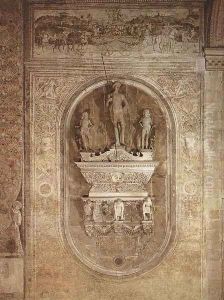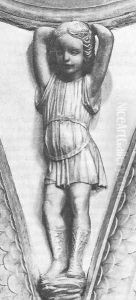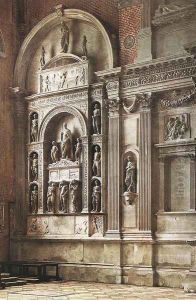Pietro Lombardo Paintings
Pietro Lombardo, also known as Pietro Solari, was an Italian Renaissance sculptor and architect, born around 1435 in Carona, now part of Switzerland, then part of the Duchy of Milan. He was a leading figure in the Lombard school of sculpture and is best known for his elegant and refined works in marble. Pietro's family, including his sons Tullio and Antonio, were also accomplished artists, and together they formed a workshop that had a significant influence on Venetian art and architecture during the late 15th and early 16th centuries.
Lombardo's early life is not well documented, but it is known that he moved to Venice around 1460, where he quickly established himself as a master sculptor. His works were characterized by their classical forms and delicate details, reflecting the transition from the Gothic to the Renaissance style. Pietro drew inspiration from ancient Roman art and the humanist principles of the time, which sought to harmonize Christian themes with the naturalistic approach of classical antiquity.
Among Lombardo's most significant works are the tombs he created for the Doges of Venice. His masterpiece is the tomb of Doge Pietro Mocenigo in the Church of Santi Giovanni e Paolo, which showcases his skill in combining architecture, sculpture, and ornamentation into a coherent and aesthetically pleasing whole. He also worked on the Church of Santa Maria dei Miracoli in Venice, which is considered one of the jewels of Venetian Renaissance architecture. Here, Lombardo's use of colored marble surfaces, relief sculptures, and architectural framing elements exemplify his masterful integration of sculpture and architecture.
Pietro Lombardo's influence extended beyond Venice as his works were sought after by patrons across the Italian peninsula. His style helped shape the Venetian Renaissance and left a lasting legacy on the city's visual culture. His sons, particularly Tullio, continued his tradition, further enhancing the reputation of the Lombardo workshop.
Pietro Lombardo died in 1515 in Venice. His work continued to be admired and studied by artists and art historians, and he is remembered as one of the pivotal figures in the development of Renaissance art in Venice. His contributions to both sculpture and architecture exemplify the Renaissance ideals of harmony, proportion, and the revival of classical antiquity.


![Monument of Pietro Mocenigo [detail #2]](https://www.niceartgallery.com/imgs/214968/s/pietro-lombardo-monument-of-pietro-mocenigo-detail-2-91c65024.jpg)

![Monument of Pietro Mocenigo [detail #1]](https://www.niceartgallery.com/imgs/214970/s/pietro-lombardo-monument-of-pietro-mocenigo-detail-1-fd0076e7.jpg)